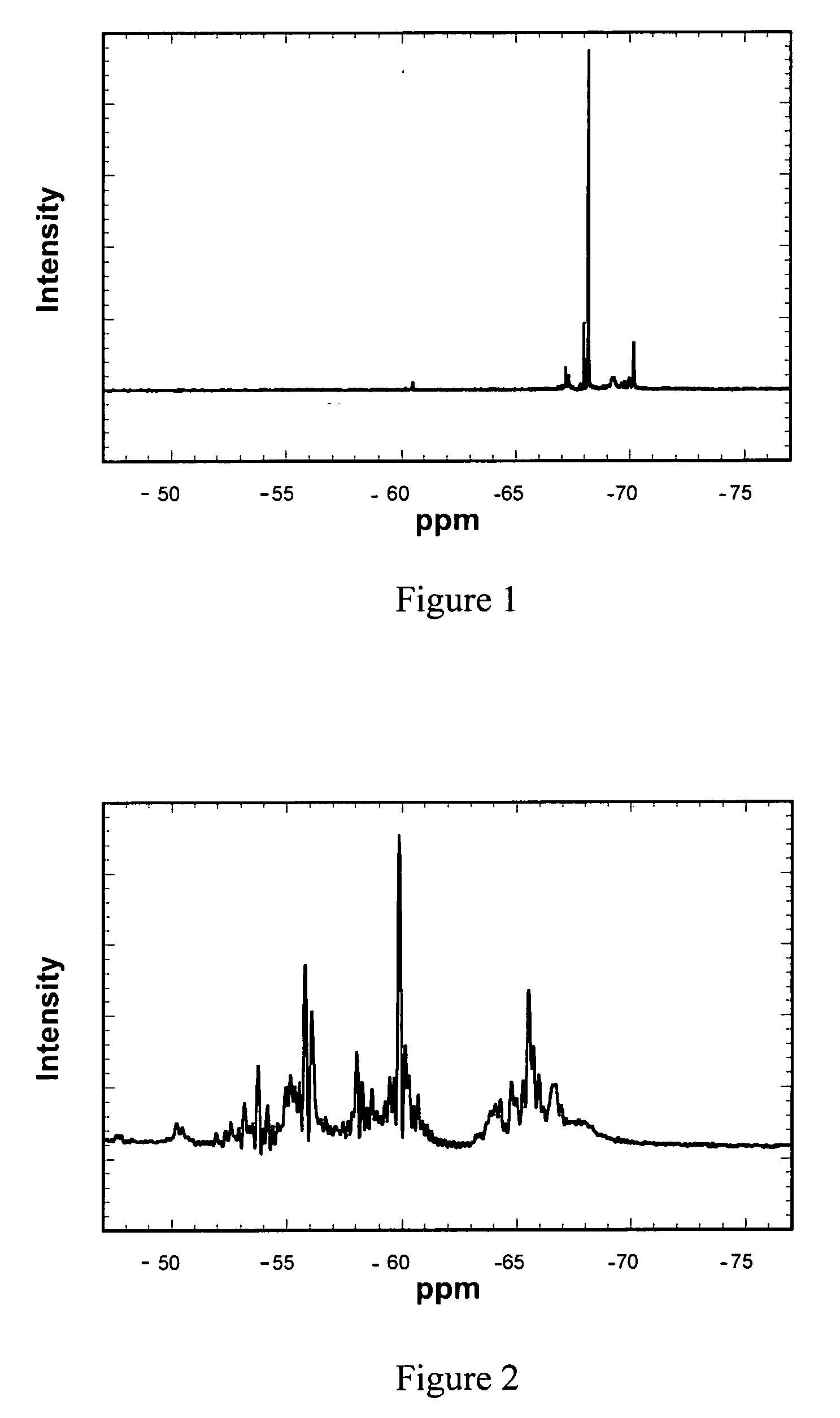Compounding silica-reinforced rubber with low volatile organic compound (VOC) emission
a technology of volatile organic compounds and compounding compounds, which is applied in the field of alkoxymodified silsesquioxane compounds, can solve the problems of poor silica dispersion and high compound viscosity, rigid uncured compound that is difficult to process, and mix silica into rubber stocks. , to achieve the effect of enhancing the interaction of polymer and filler, reducing the viscosity of compound, and reducing the viscosity
- Summary
- Abstract
- Description
- Claims
- Application Information
AI Technical Summary
Benefits of technology
Problems solved by technology
Method used
Image
Examples
example 1
[0073] Preparation of n-Octyl Alkoxy-Modified Silsesquioxane (Octyl-AMS)
[0074] In three separate reactions, 11.06 g (40 mmol) of octyltriethoxysilane (OTES) was added to 155 mL of methanol containing 6.5 mL of 12N hydrochloric acid (A) at 25° C. with stirring, (B) at 25° C. without stirring, and (C) at 60° C. without stirring. Each of these reactions gave almost identical high yields of product after 16 hrs. The majority of the product (˜90%) was isolated by separation of the lower layer with a separator funnel. The remaining ˜10% of the material was extracted with water and cyclohexane and drying at 50° C. and 0.1 mm of Hg vacuum for at least 6 hrs. A summary of these reactions is listed in Table 1.
TABLE 1Example 1: Reaction SummarySample Number1-A1-B1-COTES, g11.0611.0511.06MeOH, g121.84121.74121.7412N HCl, g8.047.697.38Product separated from alcohol, g6.15.846.23Product in alcohol layer, g0.670.880.41Approximate total yield, %102102101
[0075] An analysis of samples of the indiv...
example 2
[0077] Preparation of n-Octyl Alkoxy-Modified Silsesquioxane (Octyl-AMS) Via Semi-Continuous Synthesis
[0078] In this example, 375 mL of absolute ethanol, 17.9 mL of 12N hydrochloric acid (0.215 mol) and 27.64 g (0.100 mol) of OTES were mixed in a 1 L separatory funnel and let stand at 25° C. As product was removed, more trialkoxysiloxane and water were added, as indicated in Table 3.
[0079] The initial slow reaction in ethanol was accelerated by the addition of water with the second trialkoxysiloxane addition. Additionally, the yield for each step increased with the increased concentration of the reactants and reaction time. All of the samples were dried in a warm vacuum oven (25° C. to 45° C.) for at least 1 hr at 0.1 mm of Hg to remove all traces of residual alcohol solvent. No additional catalyst or ethanol solvent was used for the subsequent preparation.
[0080] The percent of alcohol remaining at various stages is indicated. In particular, the weight % ethanol available upon hy...
example 3
[0082] Use of Octyltrichlorosilane
[0083] The procedure of Example 2 was used except no hydrochloric acid was added and the OTES was replaced with octyltrichlorosilane (OTCS) and water. The data in Table 4 illustrate the estimated weight of product formed as a function of time and the final total obtained after two OTCS additions.
TABLE 4Example 3: Preparation of AMS in 375 mL of Ethanol and Octyltrichlorosilane (OTCS)SampleOTCSWaterTimeProduct (g)TYa% of%No.(g)(mL)(hrs.)(cumulative)(g)TYaEtOH3A24.8015.53003.750.42.44.752.8817.45.753.722.420.757.7716.5546.94.393B24.802.70.50.080.512.5615.61.7517.92108.33.2519.24116.21825.1316.55151.83 A&B32.933.199.46.76
aTY is theoretical yield.
[0084] In this example, a product similar to that of Example 2 was obtained using the OTES precursor (OTCS) and aqueous ethanol. This was shown by the 29Si NMR spectra illustrated in FIG. 3 and the alcohol analysis in Table 4. The rate of the reaction increased as more of the silane hydrolyzed to generate t...
PUM
| Property | Measurement | Unit |
|---|---|---|
| pKa | aaaaa | aaaaa |
| temperature | aaaaa | aaaaa |
| temperature | aaaaa | aaaaa |
Abstract
Description
Claims
Application Information
 Login to View More
Login to View More - R&D
- Intellectual Property
- Life Sciences
- Materials
- Tech Scout
- Unparalleled Data Quality
- Higher Quality Content
- 60% Fewer Hallucinations
Browse by: Latest US Patents, China's latest patents, Technical Efficacy Thesaurus, Application Domain, Technology Topic, Popular Technical Reports.
© 2025 PatSnap. All rights reserved.Legal|Privacy policy|Modern Slavery Act Transparency Statement|Sitemap|About US| Contact US: help@patsnap.com



